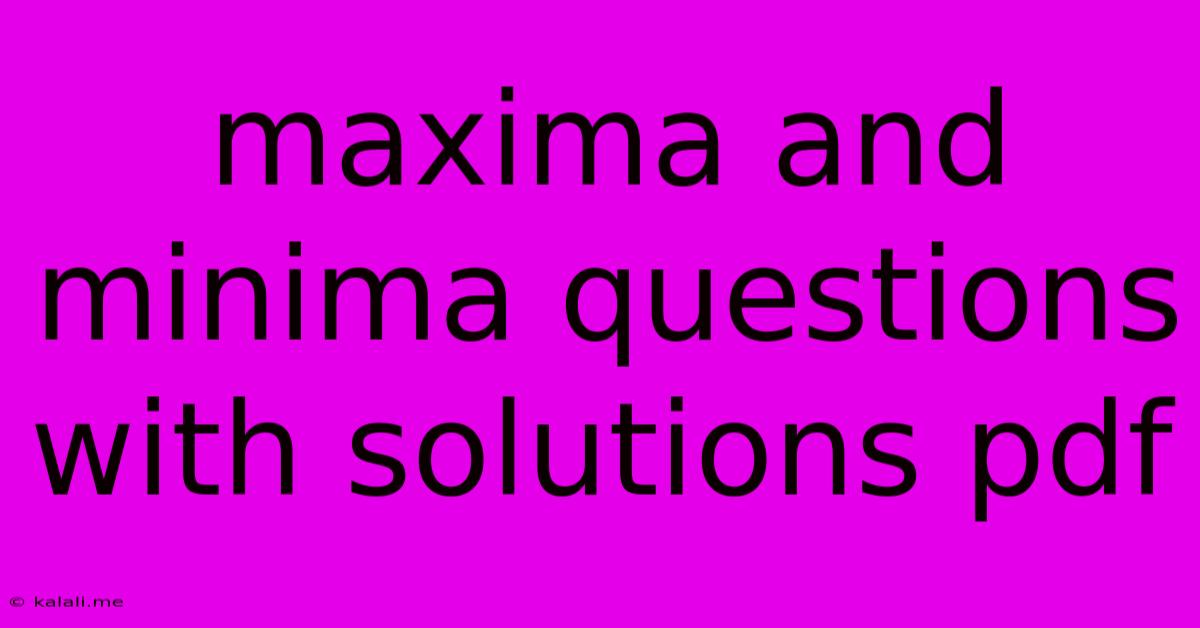Maxima And Minima Questions With Solutions Pdf
Kalali
Jun 16, 2025 · 4 min read

Table of Contents
Maxima and Minima Questions with Solutions: A Comprehensive Guide
Finding maxima and minima is a crucial concept in calculus, with applications spanning various fields from physics and engineering to economics and business. This guide provides a comprehensive overview of maxima and minima problems, along with solved examples to solidify your understanding. We'll explore different approaches and techniques to tackle these problems effectively.
This article will cover:
- Understanding Maxima and Minima: Defining critical points, local and global extrema, and the significance of the first and second derivative tests.
- Identifying Critical Points: Learning how to find potential maxima and minima using the first derivative.
- First Derivative Test: Determining whether a critical point is a maximum, minimum, or neither using the sign of the first derivative.
- Second Derivative Test: Utilizing the second derivative to classify critical points more efficiently.
- Optimization Problems: Applying the concepts of maxima and minima to solve real-world application problems involving maximizing profit, minimizing cost, or optimizing area and volume.
- Solved Examples: Step-by-step solutions to various maxima and minima problems to enhance your problem-solving skills.
Understanding Maxima and Minima
A maximum represents the highest point on a curve within a given interval, while a minimum represents the lowest point. These points are often referred to as extrema. A local maximum or minimum is the highest or lowest point within a specific region of the curve, while a global maximum or minimum is the absolute highest or lowest point across the entire curve. Critical points are points where the first derivative of a function is zero or undefined. These are the potential locations of maxima and minima.
Identifying Critical Points
To identify potential maxima and minima, we first need to find the critical points. This involves finding the derivative of the function, setting it equal to zero, and solving for x. Additionally, we need to check points where the derivative is undefined (e.g., points of discontinuity or sharp corners).
The First Derivative Test
The first derivative test helps classify critical points. We examine the sign of the first derivative to the left and right of each critical point:
- Local Maximum: If the first derivative changes from positive to negative.
- Local Minimum: If the first derivative changes from negative to positive.
- Neither: If the sign of the first derivative doesn't change.
The Second Derivative Test
The second derivative test offers a more efficient method for classifying critical points. This test involves evaluating the second derivative at each critical point:
- Local Maximum: If the second derivative is negative.
- Local Minimum: If the second derivative is positive.
- Inconclusive: If the second derivative is zero (requires further investigation using the first derivative test).
Optimization Problems: Real-World Applications
Maxima and minima principles are frequently used in optimization problems. These problems often involve finding the maximum value (e.g., profit, area) or minimum value (e.g., cost, distance) under certain constraints. Setting up the problem correctly, defining the objective function, and identifying any constraints are crucial steps.
Solved Examples
Let's consider a few examples:
Example 1: Find the maximum and minimum values of the function f(x) = x³ - 3x + 2 on the interval [-2, 2].
Solution:
- Find the derivative: f'(x) = 3x² - 3
- Find critical points: Set f'(x) = 0, which gives x = ±1.
- Evaluate the second derivative: f''(x) = 6x
- Classify critical points: f''(1) = 6 > 0 (minimum), f''(-1) = -6 < 0 (maximum).
- Evaluate function at critical points and endpoints: f(-2) = 0, f(-1) = 4, f(1) = 0, f(2) = 4.
- Conclusion: The maximum value is 4 at x = -1 and x = 2, and the minimum value is 0 at x = -2 and x = 1.
Example 2: A farmer wants to fence a rectangular enclosure using 100 meters of fencing. What dimensions maximize the area?
Solution: This involves optimizing the area given a constraint on the perimeter. The solution would involve setting up equations for area and perimeter, expressing area in terms of one variable, finding the critical point using the derivative, and verifying it's a maximum using the second derivative test.
By mastering these concepts and practicing with various examples, you can confidently tackle maxima and minima problems and their applications in diverse fields. Remember, understanding the underlying principles and choosing the appropriate technique are key to success.
Latest Posts
Latest Posts
-
How To Create Clickable Image In Html
Jun 16, 2025
-
What Are The Factors Of 121
Jun 16, 2025
-
What Is A Theme Of The Passage
Jun 16, 2025
-
A Company That Provides Access To The Internet
Jun 16, 2025
-
Which Word Is Closest In Meaning To The Underlined Word
Jun 16, 2025
Related Post
Thank you for visiting our website which covers about Maxima And Minima Questions With Solutions Pdf . We hope the information provided has been useful to you. Feel free to contact us if you have any questions or need further assistance. See you next time and don't miss to bookmark.